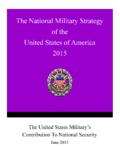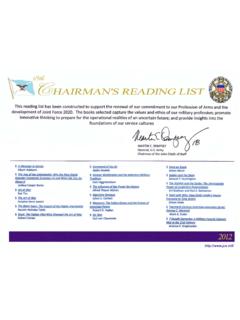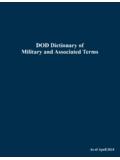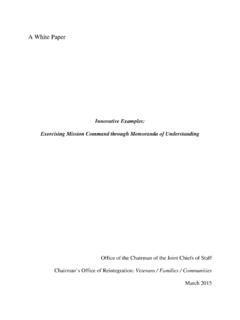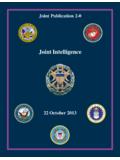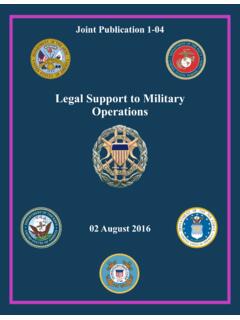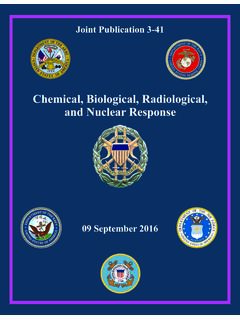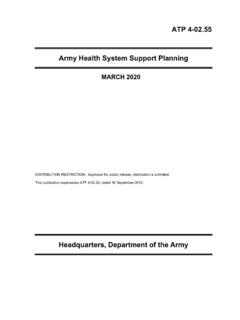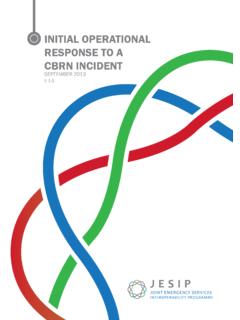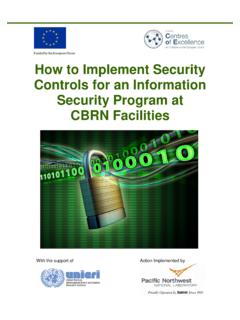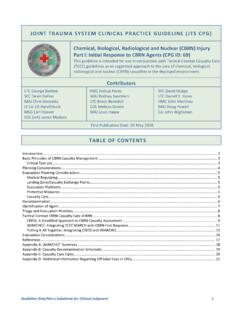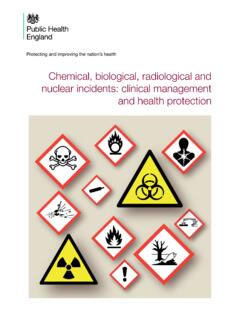Transcription of JP 3-42 Joint Explosive Ordnance Disposal
1 DEPAOTMENTFTHEARMY EUNITEDSTATSOAFAMERICRTHISWE'LLDEFENDJ oint Publication 3-42 Joint Explosive Ordnance Disposal09 September 2016 i PREFACE 1. Scope This publication provides Joint doctrine to plan, execute, and assess Explosive Ordnance Disposal support across the range of military operations. 2. Purpose This publication has been prepared under the direction of the Chairman of the Joint Chiefs of Staff (CJCS). It sets forth Joint doctrine to govern the activities and performance of the Armed Forces of the United States in Joint operations, and it provides considerations for military interaction with governmental and nongovernmental agencies, multinational forces, and other interorganizational partners. It provides military guidance for the exercise of authority by combatant commanders and other Joint force commanders (JFCs), and prescribes Joint doctrine for operations and training.
2 It provides military guidance for use by the Armed Forces in preparing and executing their plans and orders. It is not the intent of this publication to restrict the authority of the JFC from organizing the force and executing the mission in a manner the JFC deems most appropriate to ensure unity of effort in the accomplishment of objectives. 3. Application a. Joint doctrine established in this publication applies to the Joint Staff, commanders of combatant commands, subunified commands, Joint task forces, subordinate components of these commands, the Services, and combat support agencies. b. The guidance in this publication is authoritative; as such, this doctrine will be followed except when, in the judgment of the commander, exceptional circumstances dictate otherwise. If conflicts arise between the contents of this publication and the contents of Service publications, this publication will take precedence unless the CJCS, normally in coordination with the other members of the Joint Chiefs of Staff, has provided more current and specific guidance.
3 Commanders of forces operating as part of a multinational (alliance or coalition) military command should follow multinational doctrine and procedures ratified by the United States. For doctrine and procedures not ratified by the US, commanders should evaluate and follow the multinational command s doctrine and procedures, where applicable and consistent with US law, regulations, and doctrine. For the Chairman of the Joint Chiefs of Staff: KEVIN D. SCOTT Vice Admiral, USN Director, Joint Force Development Preface ii JP 3-42 Intentionally Blank iii TABLE OF CONTENTS EXECUTIVE SUMMARY.
4 Vii CHAPTER I Explosive Ordnance Disposal WITHIN THE DEPARTMENT OF DEFENSE Introduction .. I-1 Mission .. I-2 Function .. I-2 Weapons Threat in the Operational Environment .. I-2 Explosive Ordnance Disposal Capabilities .. I-2 Joint Nature of Explosive Ordnance Disposal .. I-3 Unified Action .. I-6 CHAPTER II Joint Explosive Ordnance Disposal ACTIVITIES Introduction ..II-1 Explosive Ordnance Disposal Activities Across the Phases of Joint Operations ..II-2 Military Engagement, Security Cooperation, and Deterrence Activities ..II-11 Supported Agencies ..II-16 CHAPTER III Joint Explosive Ordnance Disposal COMMAND AND CONTROL General .. III-1 Command and Control Fundamentals .. III-1 Explosive Ordnance Disposal Command and Control Considerations and Options .. III-6 Utilization and Employment Considerations of Command and Control Options .. III-7 Organizing an Explosive Ordnance Disposal Joint Task Force.
5 III-11 Explosive Ordnance Disposal Cells and Working Groups .. III-19 Interorganizational and Multinational Coordination .. III-21 CHAPTER IV Joint Explosive Ordnance Disposal PLANNING CONSIDERATIONS Overview .. IV-1 Strategic .. IV-1 Operational .. IV-2 Tactical .. IV-2 Planning Process .. IV-2 Development of Time-Phased Force and Deployment Data .. IV-6 General Planning Considerations .. IV-6 Table of Contents iv JP 3-42 CHAPTER V Joint Explosive Ordnance Disposal EXECUTION AND ASSESSMENT Overview .. V-1 Explosive Ordnance Disposal Reporting.
6 V-1 Execution of Support .. V-2 Explosive Ordnance Disposal Operational Assessment .. V-2 Activity V-4 Flexibility .. V-6 APPENDIX A Multi-Service Capability Matrix .. A-1 B Army Explosive Ordnance Disposal Assets ..B-1 C Marine Corps Explosive Ordnance Disposal Assets ..C-1 D Navy Explosive Ordnance Disposal Assets .. D-1 E Air Force Explosive Ordnance Disposal Assets .. E-1 F Explosive Ordnance Disposal Reports and Reporting .. F-1 G Explosive Ordnance Disposal Support to Law Enforcement .. G-1 H J-2 Technical Intelligence .. H-1 J References .. J-1 K Adminstrative Instructions .. K-1 GLOSSARY Part I Abbreviations and Acronyms .. GL-1 Part II Terms and Definitions .. GL-6 FIGURE II-1 Notional Explosive Ordnance Disposal Tasks Across the Joint Phases ..II-3 II-2 Explosive Ordnance Disposal and Captured Materiel Relationships.
7 II-18 III-1 Service Component Responsibility Organization .. III-7 III-2 Lead Service or Functional Componet Option .. III-9 III-3 Explosive Ordnance Disposal Naming Conventions .. III-10 III-4 Notional Explosive Ordnance Disposal Joint Task Force Organization .. III-12 III-5 Weapons Technical Intelligence-Dissemenation and Analysis Process .. III-16 IV-1 Joint Planning Process .. IV-3 V-1 Notional Mission and Lines of Operation .. V-4 V-2 Targeting Assessment .. V-5 V-3 Explosive Ordnance Disposal Robotic Platform Effectiveness .. V-7 A-1 Explosive Ordnance Disposal Capability Matrix .. A-2 B-1 Explosive Ordnance Disposal Force Structure Allocation ..B-2 Table of Contents v B-2 Notional Explosive Ordnance Disposal Group ..B-4 B-3 Notional Explosive Ordnance Disposal Battalion ..B-5 B-4 Notional Explosive Ordnance Disposal Company ..B-6 B-5 Notional Explosive Ordnance Disposal Weapons of Mass Destruction Company.
8 B-7 B-6 Notional Explosive Ordnance Disposal Company (Continental United States Support) ..B-8 B-7 Notional Explosive Ordnance Disposal Platoon ..B-8 C-1 Marine Expeditionary Force Explosive Ordnance Disposal Organization ..C-5 C-2 Marine Corps Forces Special Operations Command Organizational Chart ..C-8 D-1 Navy Explosive Ordnance Disposal Force Structure .. D-4 D-2 Explosive Ordnance Disposal Group Structure .. D-5 E-1 Air Force Ordnance Disposal Organization .. E-4 E-2 United States Air Force Explosive Ordnance Disposal Expeditionary Flight Structure .. E-5 F-1 Explosive Ordnance Disposal Report Flow of Information .. F-2 F-2 Explosive Ordnance Disposal Support to the Combatant Commander .. F-3 F-3 Level of Intelligence .. F-4 F-4 Level 1-3 Support to Operations .. F-5 F-5 Sample Explosive Ordnance Disposal 9-Line Report .. F-8 F-6 Sample Level 1 Explosive Ordnance Disposal Incident Report.
9 F-9 F-7 Sample Level 2 Explosive Ordnance Incident Report .. F-10 H-1 Sample In-Theater Analysis Capability .. H-4 H-2 Level 1-4 Exploitation .. H-5 H-3 Improvised Weapon Tactical Design .. H-8 H-4 Technical Categorization .. H-9 Table of Contents vi JP 3-42 Intentionally Blank vii EXECUTIVE SUMMARY COMMANDER S OVERVIEW Describes Explosive Ordnance Disposal within the Department of Defense Covers Joint Explosive Ordnance Activities Explains Joint Explosive Ordnance Disposal Command and Control Presents Joint Explosive Ordnance Disposal Planning Considerations Discusses Joint Explosive Ordnance Disposal Execution and Assessment Clarifies the Definition and Roles of Weapons of Mass Destruction and
10 Explosive Ordnance Disposal During Domestic and Overseas Incidents Clarifies Explosive Ordnance and Explosive Hazard Definition and Associated Terms Addresses Secretary of Defense Authority to Support Reporting of Immediate Response Requests from Civil Authorities Explosive Ordnance Disposal Within the Department of Defense Introduction Joint Explosive Ordnance Disposal (EOD) forces support freedom of maneuver and force protection (FP) and provide a critical enabling capability in the form of collection and exploitation of weapons and Explosive materiel. This capability is essential for operational success during military The primary mission of Joint EOD forces is to enable accomplishment of the Joint force and/or the geographic combatant commander s mission objectives in support of US national security by maintaining access to areas denied by Explosive Ordnance to facilitate awareness of the operational environment (OE), FP, operational mobility, and maneuver.


